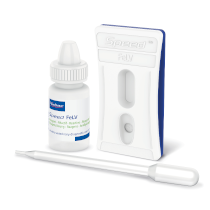
Rapid tests
Speed FeLV
Detection test for circulating FeLV (Feline Leukemia Virus) antigens in cats.
Quick et easy-to-use, Speed FeLV tests provide a result in 15 minutes only.
-
Speed FeLV technology, based on the detection of soluble antigens, makes it highly FeLV sensitive.
-
Speed FeLV does not interfere with vaccination or maternal antibodies. It can be used from an early age.
For veterinary use only
Product specifications
| Sample | Anticoagulated whole blood, serum or plasma |
|---|---|
| Target species | Cats |
| Handlings | 2 minutes |
| Time-to-results | 15 minutes |
| Storage |
Long shelf life of 24 months at room temperature (+2°C - 30°C) |
| Présentation | Box of 6 tests |
Why use Speed FeLV ?
Feline leukemogenesis virus (FeLV) infection produces highly variable and unspecific symptoms that may be common to other viral or immune-mediated diseases. In Europe, only 20-30% of cats are vaccinated against FeLV, and the disease affects around 2-3% of cats (2).
Diagnosis of FeLV is sometimes complicated by the specificity of RNA retroviruses which, after a blood and saliva viremia phase, integrate into the DNA of their host. Depending on the animal's immune response and viral load, the viral infection can evolve in several ways: abortive, regressive (latent) or progressive (active). FeLV is a serious, contagious disease that causes lymphoid tumors and is associated with a high mortality rate.
Regular screening of exposed cats, particularly before vaccination, is considered the best way to combat the virus (2).
Testing for soluble viral antigens enables us to determine the animal's status, even when the viral load in the blood is low (early infection, transient viremia, sequestered infection).
When to use Speed FeLV ?
Speed FeLV is a tool for regular monitoring of FeLV status:
- It can be used at every annual visit or before sterilization, and more frequently when a cat is regularly exposed to the virus.
- Knowing the status of new cats before introduction in a muti-cat environment to help prevent exposure of healthy cats.
- Following potential exposure to the virus, the animal's status can be tested 28 to 30 days later.
- Speed FeLV is recommended prior to FeLV vaccination, to prevent vaccine failure.
- In cats with compatible symptoms
Quick guide
1. Add 1 drop of sample into the sample well.
2. Add slowly 5 drops of reagent into the sample well.
3. Read the result at 15 minutes.

Speed FeLV performances
Internal data : 528 cat sera samples were examined, including 39 positive sera and 489 negative to FeLV virus isolation
| Reference method | FeLV Viral isolation |
|---|---|
| Sensitivity vs ref | 94.7% |
| Specificity vs ref | 99.2% |
References
(1) HARTMANN K. et coll. Quality of different in-clinic test systems for feline immunodeficiency virus and feline leukaemia virus infection. Journal of Feline Medicine and Surgery, 2007, 9, 439-445
(2) Giselbrecht et al., Prevalence of Different Courses of Feline Leukaemia Virus Infection in Four European Countries, Viruses. 2023 Aug; 15(8): 1718.
(3) Murphy et al., The Late Asymptomatic and Terminal Immunodeficiency Phases in Experimentally FIV-Infected Cats—A Long-Term Study; Viruses. 2023 Aug; 15(8): 1775.
(4) Little, Levy et al;.2020 AAFP Feline Retrovirus Testing and Management Guidelines; J of Fel Med Surg Volume 22, Issue 1, January 2020, Pages 5-30
(5) Buch J., Beall M, o’Connor T. Worldwide clinic-based serologic survey of FIV antibody and FeLV antigen in cats. ACVIM Forum Research Abstract Program, J Vet Intern Med. 2017; 31: 1315
(6) Levy JK, Crawford PC, Tucker SJ; Performance of 4 Point-of-Care Screening Tests for Feline Leukemia Virus and Feline Immunodeficiency Virus; J Vet Intern Med 2017 Mar;31(2):521-526. doi: 10.1111/jvim.14648. Epub 2017 Feb 3.






